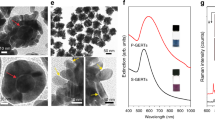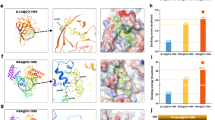Abstract
Magnetic resonance imaging (MRI) is one of the most promising techniques for the non-invasive visualization of biomarkers and biologically relevant species, both in vivo and ex vivo. Although 1H MRI with paramagnetic contrast agents, such as Gd3+ complexes and iron oxide, is widely used, it often suffers from low contrast because of the large background signals caused by the abundant distribution of protons in biological samples. Here we report the use of supramolecular organic nanoparticles to detect specific proteins by 19F-based MRI in an off/on mode. In NMR spectroscopy these designed probes are silent when aggregated, but in the presence of a target protein they disassemble to produce a sharp signal. This ‘turn-on’ response allowed us to visualize clearly the protein within live cells by 19F MRI and construct an in-cell inhibitor assay. This recognition-driven disassembly of nanoprobes for a turn-on 19F signal is unprecedented and may extend the use of 19F MRI for specific protein imaging.
This is a preview of subscription content, access via your institution
Access options
Subscribe to this journal
Receive 12 print issues and online access
$259.00 per year
only $21.58 per issue
Buy this article
- Purchase on Springer Link
- Instant access to full article PDF
Prices may be subject to local taxes which are calculated during checkout




Similar content being viewed by others
References
Kiessling, F., Morgenstern, B. & Zhang, C. Contrast agents and applications to assess tumor angiogenesis in vivo by magnetic resonance imaging. Curr. Med. Chem. 14, 77–91 (2007).
Perez, J. M., Josephson, L., O'Loughlin, T., Högemann, D. & Weissleder, R. Magnetic relaxation switches capable of sensing molecular interactions. Nature Biotechnol. 20, 816–820 (2002).
Louie, A. Y. et al. In vivo visualization of gene expression using magnetic resonance imaging. Nature Biotechnol. 18, 321–325 (2000).
Sosnovik, D. E. & Weissleder, R. Emerging concepts in molecular MRI. Curr. Opin. Biotech. 18, 4–10 (2007).
Woods, M., Woessner, D. E. & Sherry A. D. Paramagnetic lanthanide complexes as PARACEST agents for medical imaging. Chem. Soc. Rev. 35, 500–511 (2006).
Jun, Y., Lee, J-H. & Cheon, J. Chemical design of nanoparticle probes for high-performance magnetic resonance imaging. Angew. Chem. Int. Ed. 47, 5122–5135 (2008).
Danielson, M. A. & Falke, J. J. Use of 19F NMR to probe protein structure and conformational changes. Annu. Rev. Biophys. Biomol. Struct. 25, 163–195 (1996).
Yu, J., Kodibagkar, V. D., Cui, W. & Mason, R. P. 19F: a versatile reporter for non-invasive physiology and pharmacology using magnetic resonance. Curr. Med. Chem. 12, 819–848 (2005).
Higuchi, M. et al. 19F and 1H MRI detection of amyloid β plaques in vivo. Nature Neurosci. 8, 527–533 (2005).
Yu, J., Liu, L., Kodibagkar, V. D., Cui, W. & Mason, R. P. Synthesis and evaluation of novel enhanced gene reporter molecules: detection of β-galactosidase activity using 19F NMR of trifluoromethylated aryl β-d-garactopyranosides. Bioorg. Med. Chem. 14, 326–333 (2006).
Mizukami, S. et al. Paramagnetic relaxation-based 19F MRI probe to detect protease activity. J. Am. Chem. Soc. 130, 794–795 (2008).
Grage, S. L. et al. Solid state 19F NMR parameters of fluorine-labeled amino acids. Part II: Aliphatic substituents. J. Magn. Reson. 191, 16–23 (2008).
Taylor, P. W., King, R. W. & Burgen, A. S. V. Kinetics of complex formation between human carbonic anhydrases and aromatic sulfonamides. Biochemistry 9, 2638–2645 (1970).
Casini, A. et al. Carbonic anhydrase inhibitors: SAR and X-ray crystallographic study for the interaction of sugar sulfamates/sulfamides with isozymes I, II and IV. Bioorg. Med. Chem. Lett. 13, 841–845 (2003).
Talhout, R., Villa, A., Mark, A. E. & Engberts, J. B. F. N. Understanding binding affinity: a combined isothermal titration calorimetry/molecular dynamics study of the binding of a series of hydrophobically modified benzamidinium chloride inhibitors to trypsin. J. Am. Chem. Soc. 125, 10570–10579 (2003).
Green, N. M. The use of [14C]biotin for kinetic studies and for assay. Biochem. J. 89, 585–591 (1963).
Casey, J. R. et al. Carbonic anhydrase inhibitors. Design of selective, membrane-impermeant inhibitors targeting the human tumor-associated isozyme IX. J. Med. Chem. 47, 2337–2347 (2004).
Savariar, E. N., Ghosh, S. González, D. C. & Thayumanavan, S. Disassembly of noncovalent amphiphilic polymers with proteins and utility in pattern sensing. J. Am. Chem. Soc. 130, 5416–5417 (2008).
Chazalette, C. et al. Carbonic anhydrase inhibitors. Design of anticonvulsant sulfonamides incorporating indane moieties. Bioorg. Med. Chem. Lett. 14, 5781–5786 (2004).
Talhout, R. & Engberts, J. B. F. N. Thermodynamic analysis of binding of p-substituted benzamidines to trypsin. Eur. J. Biochem. 268, 1554–1560 (2001).
Finn, F. M., Titus, G., Montibeller, J. A. & Hofmann, K. Hormone-receptor studies with avidin and biotinylinsulin–avidin complexes. J. Biol. Chem. 255, 5742–5746 (1980).
Acknowledgements
We thank E. Ashihara (Kyoto University Hospital) for the blood samples, J. Miyake and T. Kunita (Kyoto University) for help with AFM and SEM measurements. Y.T. acknowledges the JSPS Research Fellowships for Young Scientists. This work was partly supported by CK integrated Medical Bio-imaging Project (MEXT) and by CREST (Japan Science and Technology Agency).
Author information
Authors and Affiliations
Contributions
I.H. conceived the project. Y.T., T.S., S.T. and I.H. designed the experiments. Y.T. performed all the experiments, with help from H.T. and M.S. on 19F NMR measurements. M.N. and T.M. performed the MRI experiments. The manuscript was written by Y.T., S.T. and I.H., and edited by all the co-authors.
Corresponding author
Supplementary information
Supplementary information
Supplementary information (PDF 928 kb)
Rights and permissions
About this article
Cite this article
Takaoka, Y., Sakamoto, T., Tsukiji, S. et al. Self-assembling nanoprobes that display off/on 19F nuclear magnetic resonance signals for protein detection and imaging. Nature Chem 1, 557–561 (2009). https://doi.org/10.1038/nchem.365
Received:
Accepted:
Published:
Issue Date:
DOI: https://doi.org/10.1038/nchem.365
This article is cited by
-
RNA structure promotes liquid-to-solid phase transition of short RNAs in neuronal dysfunction
Communications Biology (2024)
-
Recent advances in fluorescent probes for peroxynitrite detection
Journal of the Iranian Chemical Society (2019)
-
Development of fluorinated polyplex nanoemulsions for improved small interfering RNA delivery and cancer therapy
Nano Research (2018)
-
Multinuclear nanoliter one-dimensional and two-dimensional NMR spectroscopy with a single non-resonant microcoil
Nature Communications (2014)
-
A fluorinated dendrimer achieves excellent gene transfection efficacy at extremely low nitrogen to phosphorus ratios
Nature Communications (2014)



